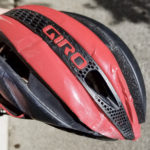Richmond bridge treacherous on two wheels
By Brett Hueston of The Aylmer Express
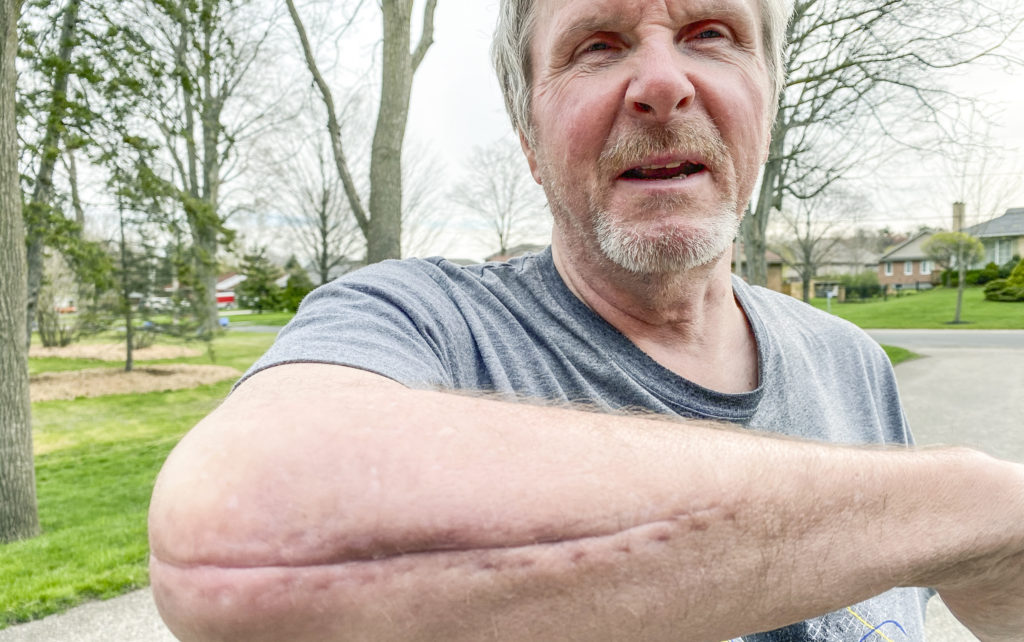
Lou Martin, a long-time Aylmer cyclist and former owner of the Canadian Tire store in town, crashed on Phillmore Bridge just outside of Richmond last summer. After three surgeries he’s still unable to make a fist or ride a bicycle. He credits wearing his helmet for not sustaining worse injuries. At least five other cyclists have crashed on the same bridge with similar and/or more serious injuries, since the bridge deck was replaced. Elgin County, which is responsible for the bridge, says it’s safe. (AE/contributed by Lou Martin).
At least six cyclists have been injured badly enough to require hospitalization after crashing on the Phillmore Bridge just south of Richmond on County Road 43 (Richmond Road) since it was resurfaced in 2016 – changed from tar-and-chip to a steel grate. And while the most recent incident occurred just a few weeks ago, Elgin County, which was told of the crash by the Express, is satisfied with the bridge as is, citing it meets current standards.
In less than the last two years, at least six cyclists – all highly experienced recreational athletes – in separate incidents, have crashed on the bridge and faced similar, life-altering injuries including reconstructive surgery and years-long rehabilitation for concussions.
Jiri Svoboda, 55, of Tillsonburg is the most recent victim. An avid cyclist – he rode 18,000 kilometres last year and almost 2,000 km outside this year before the crash – he considers himself a “pretty good bike handler.” Despite that, on April 7 he crashed on the Phillmore Bridge over the Otter Creek, heading north toward Richmond. His injuries include broken facial bones, multiple lacerations in his face, a dislocated wrist, broken hand and additional deep cuts and bruises all over his body as well as his shin, knee, hips and shoulders. He has undergone one surgery so far on his hand, with two more expected. He decided to forgo facial surgery “because the bone fragments have not moved much.”
Reached by phone at home a couple days after his crash, he noted he only rides in good weather. “I never go out when it’s raining. I know how the roads are. Wood, metal, I know they are slippery.” But on April 7, he said a very light drizzle began, just before heading home. The precipitation was so light, he noted, there was “no spray from my wheels.”
He said he cautiously approached Phillmore Bridge from the south, not trying to carry speed across before an uphill pedal into Richmond. He couldn’t estimate his speed because he can’t remember falling. He was riding alone and wearing a helmet.
The next thing he remembered was an ambulance arriving and a motorist who had stopped, offering to take Mr. Svoboda’s bicycle to his house. Another motorist gave him a blanket.
He’s now recovering at home, with lots of help from his wife. He described the pain as if he was “beaten by guys with baseball bats.” He doesn’t have enough strength in his hands to open a plastic bottle.

Jiri Svoboda of Tillsonburg is the most recent known crash victim. He crashed on April 7. The person who found him unconscious on the bridge deck thought he was dying. He has since had several surgeries including rods stuck in his hand to help heal the broken bones (see x-ray image at end of story). (AE/contributed by Jiri Svoboda)
His wife puts his socks on for him and prepares semi-liquid meals. He takes the stairs one step at a time. “I feel like a baby,” he said.
Asked what he thought of the bridge, he said “it’s like a cheese grater, and would do that to your skin.”
He noted a similar bridge over the same creek just up the road had a concrete surface and wondered why Phillmore Bridge couldn’t be like that, or why it was changed to begin with. “It would be way safer.”
The bridge was the only unfortunate drawback to Richmond Road, he said. The road was otherwise very attractive to cyclists, with its tree-lined curves and dips through the Otter Valley.
Luckily for Mr. Svoboda, Paul Van Hooydonk, who works in the area, happened to be driving by after the crash. As he approached the bridge from the north, he saw a man halfway across the bridge, “completely out cold,” flat on his back with his feet still clipped into the pedals.
There was no response when Mr. Van Hooydonk first called to Mr. Svoboda. As Mr. Van Hooydonk telephoned for an ambulance, Mr. Svoboda regained consciousness. “I don’t know how long he’d been there. I encouraged him to stay down but he stood up.”
Mr. Svoboda sat on a guardrail on the bridge and several other vehicles passed by, offering help. One gave him a blanket. “It was horrific,” said Mr. Van Hooydonk of Mr. Svoboda’s injuries. “I thought he was dying in front of me.” There was blood everywhere.
As the ambulance arrived, Mr. Svoboda still didn’t know what day or month it was. Mr. Van Hooydonk offered to take his bicycle to his house. Both men live in Tillsonburg, and, as it turned out, they knew each other. Mr. Svoboda had been Mr. Van Hooydonk’s veterinarian. He even had a cat named Jiri, after him.
When news of Mr. Svoboda’s recent crash circulated among cyclists, another rider from the Tillsonburg area told the Express he had also crashed on the Phillmore Bridge since its new steel-grate surface was installed.
Neal Koppens, 50, said he crashed hard during a morning ride in mid-summer last year. He was riding south, from Richmond toward Calton.
The weather was nice, he recalled, but at 7:30 a.m. he thought there might be dew on the bridge. Knowing that, he approached the bridge with extra caution, slowing before he was on it, then “concentrated on being smooth,” the whole way across.
Despite that effort, “the bike shot out like a bar of soap in the shower.”
While he says he didn’t lose consciousness, he called his wife right after the crash from his own cell phone and couldn’t answer some basic questions. Luckily, a passerby just then took over on his phone and summoned an ambulance.
He described his injuries as “pretty messy.” Part of the grate had sliced to the bone between his fingers, and he was told at hospital he had a concussion – he kept repeating himself there. He had been wearing a helmet. His bicycle was destroyed.
He considers himself “pretty lucky” to escape with just those injuries, plus a scraped shoulder and hips. However, he still has scars on his face, from about 12 stitches below his eye, and more above his lip.
Like Mr. Svoboda, and all six known crash victims on the bridge, Mr. Koppens is not a new or beginner cyclist. He rides several thousand kilometres a year. He specifically rides Richmond Road for the hills and scenery. He still rides there, but when he reaches Phillmore Bridge, he stops and uses the side railing to push himself across.
What does he want done to prevent crashes in future?
“Ideally, it would be great if there was a new surface, or something along the side,” he said. Even a two-foot surface for cyclists to get traction. “Anything but that,” steel grate surface.
“I went down so fast,” he noted. “Instantaneously.”
First known crash
Pat Bobier, 56, from Thamesville, crashed June 23, 2018. The first known crash victim on the bridge, she is still recovering and is only back to work for three hours a day, four days a week.
An Ironman triathlon competitor for the last 15 years (one of the toughest endurance sports which comprises a 4-kilometre swim followed by a 180-km bicycle leg and a 40-km run), Ms. Bobier was in Elgin to train on hills. The area around her home is totally flat and she had mapped out a scenic hilly ride in Malahide and Bayham with two other training partners.
She recalled “a very light mist” in the air around a golf course on Culloden Road. It stopped before she reached Richmond but there would have been some moisture on the roads.
She was riding separate from her training partners, and approached Phillmore Bridge from Richmond, headed south.
She doesn’t remember the next seven weeks.
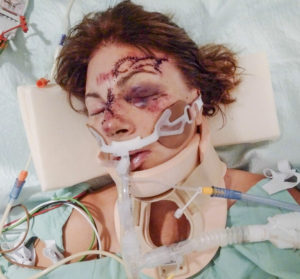
Pat Bobier crashed on June 23, 2018. She was intubated for her first few days in hospital. She had 56 stitches in her face. Nearly two years later, she is still unable to work more than about 12 hours a week, still suffering from head injuries. (AE/contributed by Pat Bobier)
Ms. Bobier crashed hard on the bridge, resulting in head injuries and 6 or 7 broken bones including both hands, a cheek bone and a leg. She received 56 stitches in her face. She was bruised from head to toe and the rings on her left hand cut down to the tendon. A joint was replaced in her right hand, which she opted for over fusing it. She was wearing a helmet.
It turned out one of her training partners had crashed just moments before her, on the same bridge, but Ms. Bobier’s injuries were much worse and she took the ambulance that was called for the first crashed rider. She was taken to Tillsonburg Hospital first but needed acute care so a doctor and a nurse rode with her to hospital in London.
She was at London Health Sciences Centre until July 5, where she was intubated. Then she was moved to Chatham Hospital until August 13, then to Parkwood Institute back in London and remained there until October 5.
In an interview Monday, May 18, she said she was still recovering from the crash, mostly the head injuries. “It’s a long process.” She works for London Health Sciences Centre, in human resources.
She started rehab again in February but, nearly two years after her crash, she’s not even jogging again. She has been on a bicycle once and a few more times on a stationary trainer at home. She doesn’t know if she’ll ever recover enough to compete in another Ironman.
The effects of her concussion persist, which has been the most difficult part of her recovery. “Dealing with light, noise, concentration, being exhausted,” were all daily challenges now. Her workdays are three hours long, then she comes home and is exhausted.
Ms. Bobier said she’s been riding in the area since 2013 and has crossed Phillmore Bridge “hundreds of times.” The road network in the Richmond area makes for a nice circuit, attractive enough to drive to from the Chatham area. She wasn’t aware of all the crashes since the deck was replaced with a steel grate.
“Now that we’re hearing of all the problems”, she added, “They should re-evaluate the bridge and decide to make improvements.”
When told the county, in response to concerns last year after hearing of two crashes resulting in critically injured cyclists, erected “slippery when wet” signs, she replied, “Big deal. It should be safe for cyclists if it’s safe for cars.”
Previously documented
Two other cyclists who crashed on the bridge were reported in the August 7, 2019 edition of the Aylmer Express.
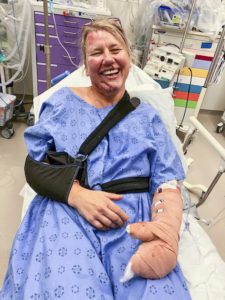
Sue Gazda, a London cyclist, crashed during the 2018 edition of the 3 Port Tour. She spent four months recovering before going back to work full-time. She required surgery to repair damage to her hand and humerus. She noted her apparent smile was a function of painkillers. (AE/contributed by Sue Gazda)
Sue Gazda, a London cyclist, crashed in August 2018 during the annual 3 Port Tour bicycle ride, whose main sponsor is the Express (and organizer is Express editor Brett Hueston). An accompanying cyclist tended to her as her blood pooled on the roadway. She was transported from the scene by ambulance and spent three months recuperating, including a six-week stay at Parkwood Hospital.
She suffered a broken hand, a dislocated shoulder with torn tendons, a broken humerus, a large hematoma on her right thigh, and deep cuts to an elbow, her chin and upper lip. Surgeries were required to repair the damage to her hand and humerus.
Ms. Gazda, who works in accounting, missed three months from her job and spent a fourth month working part-time before she returned to full-time work. An experienced rider, including racing at Forest City Velodrome, she has resumed cycling following her recovery, but she remains nervous at times.
In last year’s story she said, “It took quite a bit of time to be comfortable riding in a group. I was better when I was on my own because I needed to see what was in front of me. I rode at the velodrome again this winter, but noticed my riding wasn’t the same. I wasn’t as confident as I was prior to my accident.”
Long-time Aylmer cyclist Lou Martin spent five days in London’s Victoria Hospital after a crash on the bridge on Thursday, July 11, 2019. He underwent a five-hour surgery to repair damage to his right elbow and hand.
“My elbow was obliterated, and my hand was not far behind,” he said last year. “It’s going to be some time, but with the plates (installed during the surgery) I should be able to make a full recovery.
“I’ve ridden that road so many times I’ve lost count,” Mr. Martin, who’s been riding for over 50 years, said about Richmond Road. On the morning of his crash “there was a little bit of wetness.”
Reached in early May to check on his recovery – 10 months after the crash – Mr. Martin said he’d been through three surgeries so far. He has a plate in his right forearm, and a shattered radial head was replaced with a titanium plug. That “replaces the factory original,” he chuckled.
He also has a titanium plate in his right hand. He can now make a fist but not enough to apply any pressure. He still is unable to ride even a trainer indoor bicycle, but he’s hoping to be able to do that with “a few more months” of physiotherapy.
He’s still feeling the effects of the concussion from the head hit during the crash. Mental stress has remained as well. “I still cringe when I have to walk over a metal-grated bridge. Even in a car. I have to brace for impact, it was so traumatic.”
He credits wearing his helmet for preventing further injury or death. “The helmet did its job. Otherwise it would have been a lot worse.”
Asked what he thought of Phillmore Bridge receiving no attention since his crash last year, he said, “You’d think the county would do something to make it a little bit safer.
“It’s unfortunate the county just chose to ignore that.”
When Mr. Martin called the Express last year to report his fall, he was doing it in part to warn the organizers of the 3 Port Tour, knowing hundreds of cyclists would cross that same bridge in the annual bicycle tour in August. After the crash was reported, by the 3 Port Tour, to the county, signs indicating “slippery when wet” were installed on the approach to the bridge during the week of July 29, 2019.
During the August 18, 2019 edition of the 3 Port Tour, all cyclists were instructed by organizers to dismount and walk their bikes across a 3-foot-wide rubber mat along the side of the 130-foot-long bridge. The Tour had borrowed the mat from a donor. One rider refused to follow the instructions and rode across at a walking pace. He crashed, damaging his bicycle, but was not injured.
As he walked his bicycle across the bridge, a senior officer with the Elgin Ontario Provincial Police who was participating in the ride, mentioned to a 3 Port Tour volunteer that the bridge was dangerous.
Bicycle clubs
Two of the riders who have crashed have been members of the Silver Spokes Cycling Club, based in Tillsonburg and Norfolk area. Club President Karen Rice, in a statement about Phillmore Bridge, said “Richmond Road has always been a beautiful, scenic road,” and appealed to cyclists in particular with its “challenging hills and picturesque twists and turns.”
Since the deck was replaced with the open steel grate, she continued “a number of cyclists, including very experienced ones, began having accidents on the bridge. Several riders were seriously hurt, with multiple surgeries and very long and difficult recoveries.
“The safety of this bridge could be tremendously increased by adding a slip-resistant product on the outside of each lane. This would improve public safety by providing a durable and secure lane for cyclists and pedestrians on the bridge.”
In the meantime, Ms. Rice said, no club-sanctioned rides would cross that bridge. “Silver Spokes Cycling Club would like nothing more than to enjoy cycling the scenic roads in Elgin County again.”
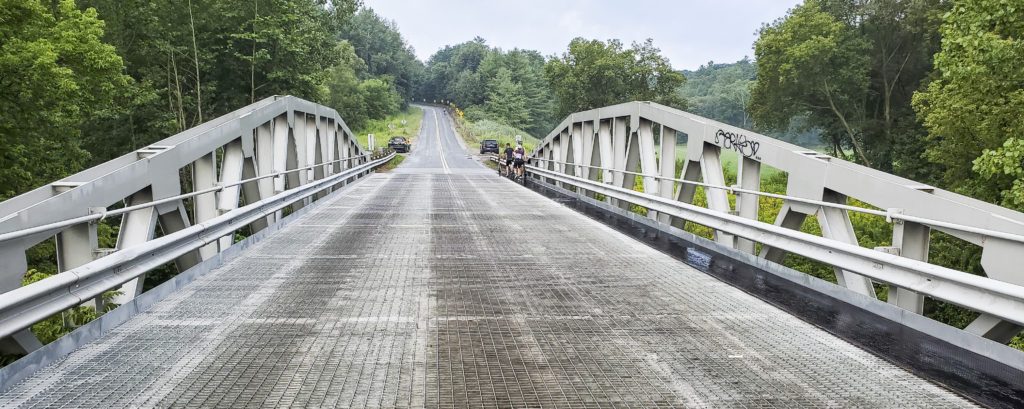
Phillmore Bridge, just south of Richmond, is considered safe by Elgin County, despite six known critical injuries suffered by experienced cyclists in less than two years. At last year’s 3 Port Tour all riders were forced to walk their bikes along a borrowed 3-foot-wide rubber mat, for safety. The only rider who refused to walk, crashed at very low speed. (AE/Brett Hueston)
Andrew Buczkowski, president of the St. Thomas-based Railway City Cycling Club, had similar sentiments. “Richmond Road is part of one of the most beautiful cycling routes in the county. There are few places in the county where a cyclist is able to climb and descend on relatively peaceful roads.
“The Railway City Cycling Club has had at least two members have completely separate incidents in the past 18 months requiring hospitalization on that specific bridge. I’m not clear on how many more people need to be hospitalized to have some kind of preventative measures taken,” he said on behalf of the club.
He called for a safer surface for cyclists to cross and noted a variety of products that could be used and still allow for proper drainage and snow plowing. He also asked for additional signage warning of the bridge surface, so cyclists could slow down and prepare for the crossing.
“We appreciate the opportunity to voice our concerns and would love to be part of a solution to this problem that stops sending cyclists to the hospital for long and painful recoveries.”
County’s response
Phillmore Bridge was originally constructed in 1992 by the Ontario Ministry of Transportation. Brian Lima, Elgin County director of engineering services, noted last year, “The previous bridge deck surface did consist of a thin tar-and-chip surface treatment layer overlaying the laminated wood deck.
“Over the years the laminated wood deck failed to last any reasonable amount of time, and replacement with concrete or asphalt was not an option as the current bridge steel truss design could not support such weight.”
At the February 12 Mayors’ Breakfast hosted by Aylmer and Area Chamber of Commerce, Express Publisher John Hueston (also a founder of the 3 Port Tour) asked Malahide Mayor and Elgin Warden Dave Mennill what the county was going to do about Phillmore Bridge and the severe injuries suffered by cyclists crossing it since it was re-decked. Mr. Mennill replied he would check with the county engineer and get an answer (the bridge is a county responsibility).
His response, dated April 9, offered no additional changes beyond the “slippery when wet” signs installed last year. The county, he noted, “has not received any direct notice of any injury incident on the bridge to date and certainly none specifically related to cycling.”
The response also said the bridge deck adhered to Canadian Standards Association standards, as well as “Ontario Regulation 104/97 – Standards for Bridges.”
He recommended the annual 3 Port Tour follow a different route, but didn’t say what cyclists using it any other time should do.
After learning of Mr. Svoboda’s crash, the Express sent additional questions to Warden Mennill and Mr. Lima, asking if their opinion of the bridge surface’s safety changed in light of another critical injury.
In response, Warden Mennill reiterated “Elgin County has not received any direct notice of any injury incident on the bridge to date and certainly none specifically related to cycling.”
The Express asked if cost was the primary reason for the steel grate deck being chosen in 2016. Warden Mennill’s letter claimed, “The primary basis of the existing deck surface was to reduce structural weight induced on the bridge structure.”
The steel grate deck cost $397,000. However, a confidential report presented to county councillors earlier this year said the county’s engineering consultant recommended an “orthotropic sandwich plate system” at an estimated $698,000.
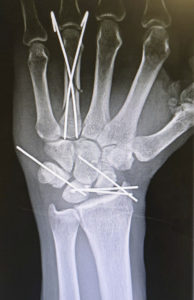
An X-ray image of Mr. Svobodas left hand shows the rods stuck in his left hand to help heal the broken bones following his crash on the Phillmore bridge. (AE/contributed by Jiri Svoboda)
Mr. Svoboda, on hearing that six or more critical injuries had occurred on Phillmore Bridge since it was re-decked, asked “in this litigious society, aren’t they afraid of someone suing?
“It used to be a normal bridge. I don’t know why they turned it into this monster.”
He has shared some of his recovery experience so far, which includes drilling into bones in his left hand to place surgical steel rods to help correct the position of his fourth metacarpal.
His advice on May 3 after that surgery: “If you can avoid a situation which would lead to drilling through your wrist bones, do it, I mean avoid it. It is no fun. The day after the surgery was the worst day of my life (and I had 3 knee surgeries in the past).”
-
Jim Humphrey
-
jerry klingenberg
-
-
Randy Van Puyenbroeck


